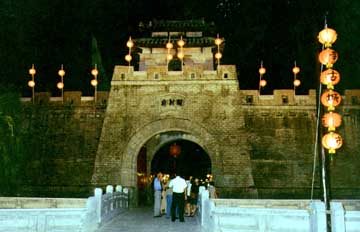 |
A Brief
History of Taiwan |

Upon occupying Taiwan, the Japanese
created a transportation infrastructure including railways, highways and
harbors, improved public health by setting up modern Western-style medical
facilities, created schools, and established the foundation for administrative
bodies and a legal system. Taiwan's focus on agricultural was maintained and
revolutionary agricultural techniques were introduced, developing a large sugar
cane industry and providing rice for Japan. The colonial relationship between an
industrial Japan and agricultural Taiwan was thereby established.
In the years before 1920, Japan created a
basic infrastructure on Taiwan just as World War I presented economic
opportunities. At this time Taiwan saw rapid economic growth and many Taiwanese
either renovated or built new homes. The Japanese colonial government began
carrying out urban planning, and many small modern towns took root. Thanks to
the policy of universal education by the colonial government, Taiwan's first
generation of intellectuals emerged around 1920. They staged a cultural movement
in the 15th year of the Showa era, started magazines and newspapers, and held
lectures to espouse the modern Western tenets of democracy and rationalism. They
even became politicized to the point of seeking establishment of a colonial
self-rule political entity.
In the late 1930's as Japanese imperialism
further developed, the Japanese colonial government began to assimilate the
Taiwanese, referring to the Taiwanese as subjects. Taiwanese were strongly
encouraged to adopt a Japanese lifestyle, but the movement had only limited
success. On the other hand, due to needs of the war, the Japanese colonial
government used Taiwan labor to build roads in rural areas, to construct
military installations and the like. After entering the Pacific War, Taiwanese
were mobilized on the war front. In 1945 Japan surrendered. The Allied forces
Pacific commander, General MacArthur, ordered that the Japanese imperial
government and forces surrender to China, bringing to an end the Japanese
colonial period in Taiwan.
Not long after Taiwan emerged from
Japanese colonial rule, the Nationalism lost the Chinese civil war and retreated
to Taiwan in 1949. Soon after, the Korean War erupted and Taiwan became a key
link in the line of defense against socialism in the Western Pacific during the
Cold War. Up until the mid-1960's, Taiwan received military and economic
assistance from the United States. This was a period of Americanization of
Taiwan. Western art, culture, and architecture were introduced to Taiwan during
the period of U.S. assistance.
After the 1970's, the Cold War began to
thaw. The Republic of China was forced out to the United Nations and Japan, the
U.S. and other nations served diplomatic relations. As this time, there was criticism that Taiwan had become overly Westernized and a policy
focusing on local culture should be implemented. Thereafter, various degrees of
compromise were reached between local and foreign culture. Especially after the
mid-1980's, the advancement of democracy, freedom and internationalism made the
integration of these cultures all the more vibrant and diverse.
time, there was criticism that Taiwan had become overly Westernized and a policy
focusing on local culture should be implemented. Thereafter, various degrees of
compromise were reached between local and foreign culture. Especially after the
mid-1980's, the advancement of democracy, freedom and internationalism made the
integration of these cultures all the more vibrant and diverse.
Previous Page
|
 |


 time, there was criticism that Taiwan had become overly Westernized and a policy
focusing on local culture should be implemented. Thereafter, various degrees of
compromise were reached between local and foreign culture. Especially after the
mid-1980's, the advancement of democracy, freedom and internationalism made the
integration of these cultures all the more vibrant and diverse.
time, there was criticism that Taiwan had become overly Westernized and a policy
focusing on local culture should be implemented. Thereafter, various degrees of
compromise were reached between local and foreign culture. Especially after the
mid-1980's, the advancement of democracy, freedom and internationalism made the
integration of these cultures all the more vibrant and diverse.